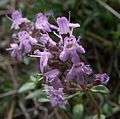Thymus serpyllum
| Thymus serpyllum | |
|---|---|
 | |
| Scientific classification | |
| Kingdom: | Plantae |
| (unranked): | Angiosperms |
| (unranked): | Eudicots |
| (unranked): | Asterids |
| Order: | Lamiales |
| Family: | Lamiaceae |
| Genus: | Thymus |
| Species: | T. serpyllum |
| Binomial name | |
| Thymus serpyllum L.[1] | |
| Synonyms[2] | |
|
List
| |
Thymus serpyllum, known by the common names of Breckland thyme,[3] wild thyme or creeping thyme, is a species of flowering plant in the mint family Lamiaceae, native to most of Europe and North Africa. It is a low, usually prostrate subshrub growing to 2 cm (1 in) tall with creeping stems up to 10 cm (4 in) long. The oval evergreen leaves are 3–8 mm long. The strongly scented flowers are either lilac, pink-purple, magenta, or a rare white, all 4–6 mm long and produced in clusters. The hardy plant tolerates some pedestrian traffic and produces odors ranging from heavily herbal to lightly lemon, depending on the variety.
Description
Wild thyme is a creeping dwarf evergreen shrub with woody stems and a taproot. It forms matlike plants that root from the nodes of the squarish, limp stems. The leaves are in opposite pairs, nearly stalkless, with linear elliptic round-tipped blades and untoothed margins. The plant sends up erect flowering shoots in summer. The usually pink or mauve flowers have a tube-like calyx and an irregular straight-tubed, hairy corolla. The upper petal is notched and the lower one is larger than the two lateral petals and has three flattened lobes which form a lip. Each flower has four projecting stamens and two fused carpels. The fruit is a dry, four-chambered schizocarp.[4]
Distribution and habitat
Wild thyme is native to the palearctic zone of Europe and Asia. It is a plant of thin soils and can be found growing on sandy-soiled heaths, rocky outcrops, hills, banks, roadsides and riverside sand banks. Wild thyme is one of the plants on which both the common blue butterfly and large blue butterfly larvae feed and it is also attractive to bees.[4] [5]
Cultivation
Creeping and mounding variants of T. serpyllum are used as border plants and ground cover around gardens and stone paths. It may also be used to replace a bluegrass lawn to xeriscape low to moderate foot traffic areas due to its tolerance for low water and poor soils.[6][7][8]
Numerous cultivars have been produced, of which 'Pink Chintz' has gained the Royal Horticultural Society's Award of Garden Merit.[9] A miniature creeping form is 'Elfin'.[10]
Gallery





 var. albus
var. albus var. albus
var. albus Thymus serpyllum coccineus
Thymus serpyllum coccineus- Wild thyme in the UBC Botanical Garden
Illustrations
References
- ↑ Linnaeus. Sp. Pl. 590 1753.
- ↑ "The Plant List: A Working List of All Plant Species".
- ↑ Schauer, Thomas (1978). A Field Guide to the Wild Flowers of Britain and Europe, Collins, London, p. 184. ISBN 0-00-219257-8.
- 1 2 "Breckland Thyme: Thymus serpyllum". NatureGate. Retrieved 2013-12-13.
- ↑ http://butterfly-conservation.org/files/caterpillar-food-plants.pdf
- ↑ "Thyme, the Fragrant Ground Cover". Fine Gardening.
- ↑ "Planting and Maintaining a Thyme Lawn". GardenGuides.
- ↑ http://www.gardenersgardening.com/xeriscape-dry-climate.html
- ↑ "RHS Plant Selector - Thymus serpyllum 'Pink Chintz'". Retrieved 6 June 2013.
- ↑ "Elfin Thyme Care – How Do I Plant Elfin Thyme In The Garden". Gardening Know How.
- ↑ http://butterfly-conservation.org/files/caterpillar-food-plants.pdf
External links
| Wikimedia Commons has media related to Thymus serpyllum. |
| Wikispecies has information related to: Thymus serpyllum |




